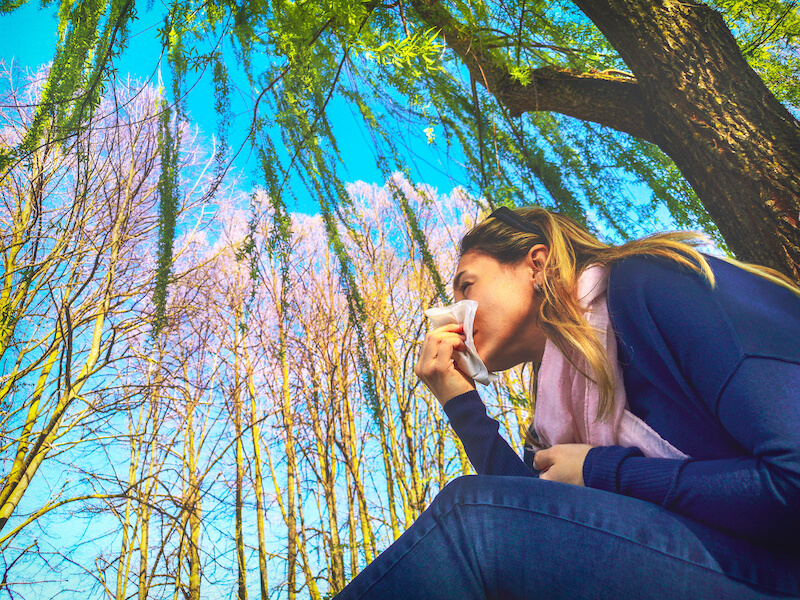
Ah, Spring! After a long winter, it’s wonderful to finally open those windows, take a deep breath of fresh air… and start sneezing. Okay, the sneezing part isn’t so great. But there’s no questioning the reality: allergy season is here.
In general, allergy season goes from March through October of any given year. So, are you going to be managing nine months of itchy eyes and runny nose? Well, not necessarily. And there are a few reasons why you may have some relief to look forward to.
What are seasonal allergies?
We are usually referencing seasonal allergies when we talk about “allergy season”. But let’s back up and understand what causes allergies in order to better comprehend what seasonal allergies are. When a harmless substance is mistaken by your body for a dangerous one, your body activates your immune system to protect you.
Itchy eyes, sneezing, coughing, runny nose, and other cold like symptoms, generally related to seasonal allergies, are normally the result. Depending on the allergen, people could also experience swelling, difficulty breathing, or more severe symptoms.
The human body, of course, has no limit to what it could be allergic to. But it’s fairly common for individuals to be allergic to outdoor particulates, such as pollen or mold spores. Because those pollens (or spores or other particles) tend to appear seasonally (every spring, for instance), you wind up with allergy symptoms that also surface seasonally: hence, seasonal allergies.
Planning the 2022 allergy season
So what can you expect for the 2022 allergy season? You’ll probably need to take a look at the year on a monthly basis in order to attempt to generate realistic expectations.
Allergies in April
In April, it’s usually the trees outside your house that are causing your sneezing and coughing. This could come as a surprise to some because most people don’t view trees as particularly offensive. But trees are pollinating plants, too!
Different kinds of trees will pollinate during different times of the spring, so if you find the first few weeks of April especially difficult, it’s because you may be allergic to Ash trees or Maple trees, and that determines when you start sneezing. Typically, the best way to control your symptoms during this time is to track the daily pollen count (usually you can find this on any weather app or the local news) and stay in when the count gets too high.
Allergies in May and June
The next group of allergenic plants usually begin flowering in May and June. Grasses and flowers are usually the sources of these pollens. Because of the copious amount of rain that falls during April, May, and June, these pollens are normally quite potent and widespread. This means that if you’re allergic to these green grasses and flowering plants, May and June will most likely bring about prolonged symptoms.
Try to get any outside work done in the morning or evening as these pollen counts tend to reach a peak in the early afternoon.
In July, you might get a break
It’s dryer in July on average. This means you might actually get a break from allergy symptoms. This will, naturally, depend on local weather patterns during any given year. Still, if you have to organize that outdoor family reunion, July will probably be the best time to do it!
August through October allergies
Don’t get used to the allergy level in July though. Because ragweed peaks in August. The allergy symptoms from ragweed, also known as “hay fever” are extremely common.
And what’s worse, ragweed hangs around a while. You could be dealing with this particular allergen all the way into October. Naturally, ragweed isn’t the only allergen that sticks around until the ground freezes. Mold allergens can also be really persistent at this time of year, too.
How to deal with seasonal allergies
Dealing with your seasonal allergies can be a challenge. You can try to figure out what allergens are triggering your symptoms by noting when they occur. But you might have to give us a call for a consultation to really figure out the source of your allergies.
Still, you can figure out how to plan your year by knowing what time of the year certain allergies peak. That’s relevant for the 2022 allergy season and it will still be relevant for the 2023 allergy season. You can anticipate a little bit of variation from year to year (in general, allergy seasons feel like they’re getting longer and more severe all the time), but keep an eye on your local and regional weather reports, also.
You can still enjoy being outdoors even if you have seasonal allergies. Though, it may mean you’ll benefit from a little extra planning (and maybe an antihistamine).
References
https://www.mayoclinic.org/diseases-conditions/allergies/symptoms-causes/syc-20351497#:~:text=Common%20allergy%20triggers%20include%3A,from%20a%20bee%20or%20wasp